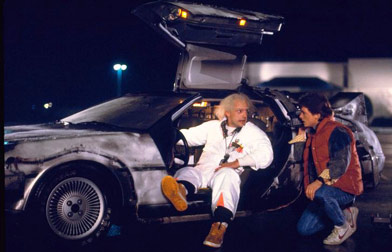Back to the future
 Remember
Back to the Future, the famous movie in which mad scientist Doc
(Christopher Lloyd) and maverick young adventurer Marty McFly (Micheal J
Fox) travel to the future? In the second part of this well known movie
franchise that was released 30 years ago, the world in 2015 was depicted
to be having hoverboards, flying cars, life-like holographic displays,
drones, video conferencing, portable fusion power and several other
inventions which were unthinkable back then. Incidentally, they
travelled to October 21, 2015, which was celebrated last week around the
world as Back to the Future Day. Remember
Back to the Future, the famous movie in which mad scientist Doc
(Christopher Lloyd) and maverick young adventurer Marty McFly (Micheal J
Fox) travel to the future? In the second part of this well known movie
franchise that was released 30 years ago, the world in 2015 was depicted
to be having hoverboards, flying cars, life-like holographic displays,
drones, video conferencing, portable fusion power and several other
inventions which were unthinkable back then. Incidentally, they
travelled to October 21, 2015, which was celebrated last week around the
world as Back to the Future Day.
Did the filmmakers predict 2015 correctly? They did, to some extent.
Two types of hover-boards actually exist, but they are not yet available
for sale to the public. One is made by Lexus and the other by a
Californian company called Hendo. The technology will no doubt be
perfected in around five years, so that is one prediction they got
right.
Flying cars also do exist, though they are not obviously in everyday
use. Terrafugia's updated flying car will find the first buyers around
2017 and several other manufacturers are bringing their own designs to
the table. Flying cars too should be common in around 20 years' time.
Holographic
Video conferencing via the Internet is not only common, but is also
free for all intents and purposes. Anyone with a smartphone can make
video calls now. Holographic displays are getting better all the time
and they are even talking about glassless 3D TV displays (Toshiba
already has one). Incidentally, director Robert Zemeckis correctly also
predicted the rise of the flat-screen TVs, which have almost entirely
replaced CRT TVs now. (Flat screen Plasma technology, itself obsolete
now, was nascent at the time so it was not very difficult to guess).
Drones have come a long way since they were first seen in the film.
Military drones are highly advanced devices which can actually fire on
an intended target but civilian drones are getting increasingly
sophisticated and are widely used in photography.
|

A still from Back To The Future
pic. fox13now.com |
Nike is getting ready to release shoes with power laces as seen in
the film (Nike also designed the pair actually used in the film). Iris
and fingerprint recognition devices, depicted in the film, are also
common now. The film also got another prediction right - the tablet
computer.
A major invention that featured in Back to the Future II was the
Black & Decker Hydrator. This was a kitchen device that could turn
raisins back into grapes and stale pizza into a freshly delivered snack.
Food
Food 3D printers already exist on a limited scale and NASA is already
experimenting with 3D printed food for missions to Mars and beyond.
However, we are still a long way off from any form of fusion power,
leave alone portable fusion power that works off garbage. But scientists
are working on it and it could be a possible source of power within the
next 50 years at least.
The Back to the Future anniversary has created another craze -
predicting life 30 years from now - in 2045. Granted, some of us will
not be around by that time, but it is always interesting to read the
future. When 2045 comes, people will be able to check how many of those
predictions have come true.
Given the rapid rate of technological progress, it is easy to guess
some of these such as driverless cars (they already exist on an
experimental basis), hydrogen powered cars (already being manufactured
on a small scale), flying cars, bionic individuals (many organs will
have artificial equivalents and some organs already do), longevity
treatments (the first person to live beyond 150 has most likely been
born already) and the eradication of many more diseases. Even a cure for
cancer does not seem to be a difficult challenge.
Wired
It is also fairly easy to guess that the world in 2045 will be highly
wired, with internet speeds that we can barely imagine now. Physical
media such as blu-ray will still exist, but only just.
It is still hard to imagine where television will be in 30 years, but
it will be much different. The Internet of Things, where almost every
device from the TV to the refrigerator is connected, is already well
established in advanced developed countries and it can only get bigger
and better in 30 years. One cannot imagine the shape and form of
smartphones, but expect foldable displays to be commonplace.
Artificial intelligence will be a really big thing by 2045, with
machines and robots that can virtually think for themselves. Whether
they will be able to experience human emotions is another matter
altogether. But household robots could be common by 2045, given that
robotic gadgets such as vacuum cleaners are already in the market.
It will also be possible to fuse biological and artificial nerves
together. Renewable power sources will also be a major component of our
energy grids, with fossil fuels on the way out literally (not counting
reserves held by some countries, the oil supply is slated to run out by
around 2060).
Nanotechnology will give us technologies now unheard of, while new
materials will literally alter the shape of all our structures from
buildings to cars. Smart cities will also exist by this time, with at
least preliminary work done on undersea communities. We should have
travelled to Mars by 2045, as depicted in the film Martian starring Matt
Damon.
Future
Predicting the future is a very tricky business, because inventions
take place at an alarming rate. Just 30 years ago if someone said that
CRT TVs would be almost totally wiped out by 2015, no one would have
believed him. Yet it has happened today. But with certain evolving
technologies, we know what will happen in the future, such as driverless
cars, which are already possible. There will always be people like our
very own Sir Arthur C. Clarke who have an uncanny ability to predict the
future. Science fiction, in the form of books and movies, will remain
the only other alternative for getting a glimpse of the future which we
are reaching with every passing second.
|

